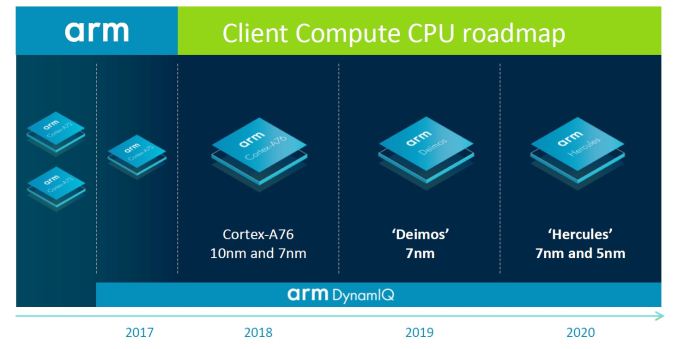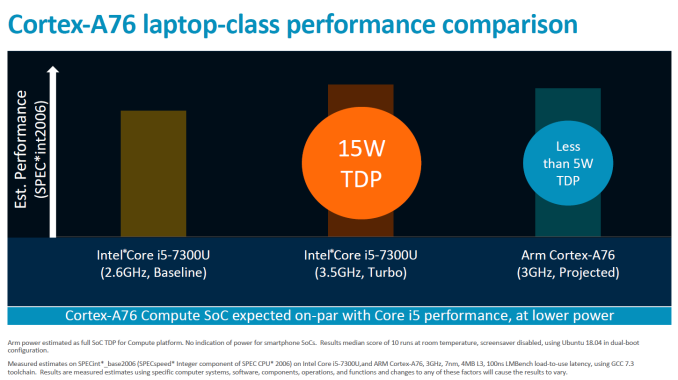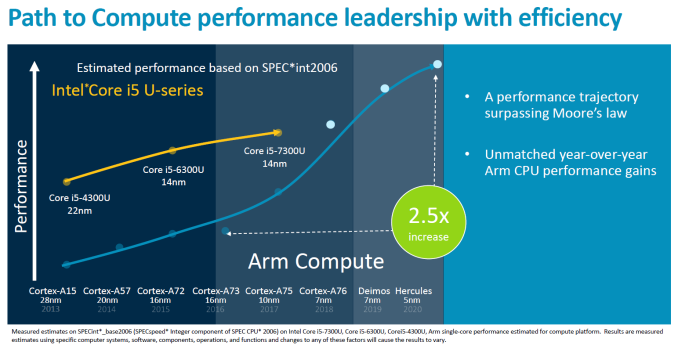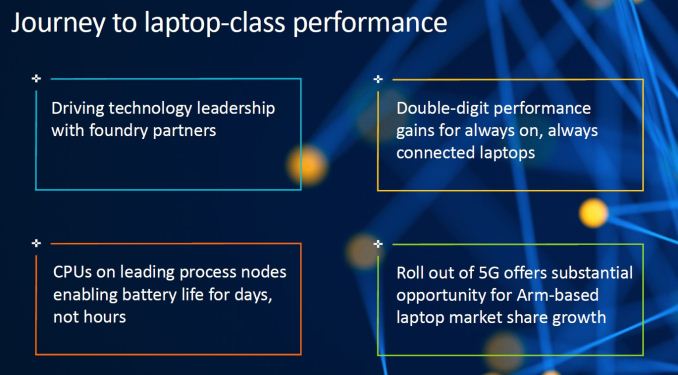Arm Unveils Client CPU Performance Roadmap Through 2020 - Taking Intel Head On
by Andrei Frumusanu on August 16, 2018 9:05 AM EST
Today’s announcement is an oddball one for Arm as we see the first-ever public forward looking CPU IP roadmap detailing performance and power projections for the next two generations through to 2020.
Back in May we extensively covered Arm’s next generation Cortex A76 CPU IP and how it’s meant to be a game-changer in terms of providing one of the biggest generational performance jumps in the company’s recent history. The narrative in particular focused on how the A76 now brought real competition and viable alternatives to the x86 market and in particular how it would be able to offer performance equivalent to Intel’s best mobile offerings, at much lower power.
Arm sees always-connected devices with 5G connectivity as a prime opportunity for a shift in the laptop market. Qualcomm’s recent Snapdragon 835 and Snapdragon 850 platforms were the first attempts in trying to establish this new slice for Arm-based PCs.
Today’s roadmap now publicly discloses the codenames of the next two generations of CPU cores following the A76 – Deimos and Hercules. Both future cores are based on the new A76 micro-architecture and will introduce respective evolutionary refinements and incremental updates for the Austin cores.
The A76 being a 2018 product – and we should be hearing more on the first commercial devices on 7nm towards the end of the year and coming months, Deimos is its 2019 successor aiming at more wide-spread 7nm adoption. Hercules is said to be the next iteration of the microarchitecture for 2020 products and the first 5nm implementations. This is as far as Arm is willing to project in the future for today’s disclosure, as the Sophia team is working on the next big microarchitecture push, which I suspect will be the successor to Hercules in 2021.
Part of today’s announcement is Arm’s reiteration of the performance and power goals of the A76 against competing platforms from Intel. The measurement metric today was the performance of a SPECint2006 Speed run under Linux while complied under GCC7. The power metrics represent the whole SoC “TDP”, meaning CPU, interconnect and memory controllers – essentially the active platform power much in a similar way we’ve been representing smartphone mobile power in recent mobile deep-dive articles.
Here a Cortex A76 based system running at up to 3GHz is said to match the single-thread performance of an Intel Core i5-7300U running at its maximum 3.5GHz turbo operating speed, all while doing it within a TDP of less than 5W, versus “15W” for the Intel system. I’m not too happy with the power presentation done here by Arm as we kind of have an apples-and-oranges comparison; the Arm estimates here are meant to represent actual power consumption under the single-threaded SPEC workload while the Intel figures are the official TDP figures of the SKU – which obviously don’t directly apply to this scenario.
We didn’t have internal data to verify Arm’s claims as of publishing of the article, but the 15W Intel figure is naturally on the high side, given that this just the official TDP representing multi-threaded workloads – a very quick test of CB15 ST power as reported by MSR registers on an 7200U at 3.1GHz measured 9.3W package+DRAM power while an 8250U at 3.35GHz came in at 11W. I haven’t correlated SPEC power on x86 to date, but I’m expecting it on average to be less than CB15. Even if the 15W figure for the 7300U is correct, and I’m expecting something more in the range of 9-11W, Arm might be using one of Intel’s notably less efficient performance points when doing the comparison for these SKUs. Of course this doesn’t invalidate the data as efficiency for the A76 at those frequencies would also not be optimal, it’s just something to keep in mind.
It’s also interesting to see Arm scale back on the performance comparison as they’re using a 3GHz A76 as the comparison data-point – this is in contrast to the 3.3GHz maximum 5W performance point presented during TechDay. I had tried to estimate the A76’s power in mobile form-factors based on the different metrics Arm disclosed and came at an estimated 2.3W at 3GHz. Naturally Arm says “less than 5W” and they could be erring on the safe side of not over-promising – but if it had been *that* much lower, as in my estimate, we would have maybe seen even more aggressive marketing figures. In the end, until we get the first A76 devices in our hands, we won’t know for sure what the exact figures will be and at which point on the efficiency curve Arm’s projected 3GHz performance figures will end up at.
The last slide that is notable to talk about is the performance projections for Deimos and Hercules. Here Arm’s taking a direct stab at Intel’s lack of significant progress over the last few years and reiterating its confidence in the company’s ability in sustaining high CAGR (compound annual growth rate) performance figures for the next generations.
Again at TechDay we quoted figures of 20-25% while today’s announcement contained a more conservative figures of “>=15%” – likely better representing a seemingly larger 20% projected boost for Deimos as well as what seems to be a 10% gain for the 5nm follow-up Hercules. Taking into account the relative positioning of the data-points in this chart, I did some quick correlation and it matches my initial estimated performance figures for a 3GHz A76 at around ~26 SPECint2006. Deimos and Hercules would come in at figures of ~31 and ~34 points.
Finally today’s announcement is a marketing exercise attempting to emphasise Arm’s performance and power commitments over the next few generations, trying to showcase it has the strategy and technology in place to make the Arm laptop market a real growth opportunity. If and how this pans out is something that we won’t find out at least until later on in the year, with the first actual A76 based large form-factor designs not being a thing until at least sometime in 2019. We’re eagerly awaiting the first A76 based mobile designs in the months to come and to have a first hand-on evaluation of the new microarchitecture family.















102 Comments
View All Comments
rocky12345 - Thursday, August 16, 2018 - link
This is all well and good but if it can not run x86 code natively then it is all for nothing. We allknow Intel will not hand them a x86 license so all they will have is to be able to do it through emulation which is a lot slower than running it with true x86. ARMs CPU cores would have to be at least 40%-50% faster than Intel's to match running x86 software.Maybe in 6-10 years after companies like MS and Apple push for non x86 Apps they would have a chance in the market and x86 coded programs start to be less important in the market.
Dragonstongue - Thursday, August 16, 2018 - link
not to mention x64 which is pretty much AMD cross license x86 backbone..I wonder where they (mobile) get 64bit compute from?Dr. Swag - Thursday, August 16, 2018 - link
What do you mean by "where"? Obviously there's ARMv8 or whatever it is that's 64 bit, but it's arm not x86close - Friday, August 17, 2018 - link
Intel and AMD do x86-64 instruction set. ARM does the A64 instruction set. Both 64bit, no connection between the 2. Intel and AMD don't have exclusivity on everything 64bit.goatfajitas - Monday, August 20, 2018 - link
"Intel and AMD don't have exclusivity on everything 64bit."Correct, but they do have x86 and x-86-64 exclusivity. That is what most of the world runs off of, including every manufacturing facility that makes every ARM processor, every Apple and Android device and pretty much everything else you can purchase. Its not a "straglehold" but its pretty close to it. It will take a long time to change that.
lartech - Thursday, February 28, 2019 - link
@goatfajitas, I'm a little confused by your posting. You start out talking about x86/x86-64 "stranglehold" which, granted, is mostly true in the datacenter and workstation spaces.But then you talk about "every Apple and Android device and pretty much everything else you can purchase". However, *none* of those run on x86 -- 95% of mobile devices (including smartphones and tablets) and the vast majority of embedded processors (our cars are full of them) are Arm-based. Arm processor volume (running 12+ billion/yr, and accelerating) totally dwarfs x86 volumes.
Arm is already making inroads in the PC (laptop) space, in the new breed of Arm-based Windows 10 laptops. Even Apple said that *it* was moving away from Intel processors in its Macs starting ~2020, but hasn't specifically said what would replace them (although there is an obvious candidate).
Granted, long experience says to never underestimate Intel, when it is competitively challenged (just ask Transmeta, Cyrix, AMD, and others about that). But underlying instruction set architectures (ISAs) aren't as much of a lock-in as they used to be -- it looks like x86's previous "stranglehold" is weakening considerably, working its way from the laptop space upwards. (...not unlike what Intel did to PA-RISC, Alpha, MIPS, and SPARC, working its way up the chain from low-end to higher-end systems)
UpSpin - Thursday, August 16, 2018 - link
I doubt it will take 6-10 years. Rumors are, that Apple will ditch Intel soon. Mobile devices running Android, iOS or any other mobile OS are optimized for ARM already. Linux can run on both x86 and ARM. Windows runs natively on ARM, too. So the only popular software stuck on x86 is old or larger Windows programs. But these programs also don't run on a low voltage Core processors but on workstation class processors, which ARM doesn't compete, yet. And the few remaining older programs should run in emulation just fine.I own a QNAP NAS and it's quite obvious that QNAP releases more new ARM NAS than x86 NAS. They also ported almost all the x86 only features to ARM devices now. So it's obvious, ARM is close to Intel regarding low power performance.
Manch - Thursday, August 16, 2018 - link
Or maybe a NAS just doesn't require the compute power of a x86 based chip. I think that's a bit of a bad comparison without benches to put your comment in context.UpSpin - Thursday, August 16, 2018 - link
Please consider my last sentence: "ARM is close to Intel regarding low power performance." And a QNAP or Synology NAS offers more than a WD NAS, and they offer the advanced features on ARM NAS now, too, at least in the case of QNAP:https://www.qnap.com/event/containerx31plus/en/
https://www.qnap.com/solution/arm-snapshots/en/
I just wanted to point out, Intel has a hard time in this segment already, and will have an even harder time in their Ultrabooks with the upcoming ARM SoCs.
imaheadcase - Thursday, August 16, 2018 - link
From that NAS article from Synology, it doesn't seem its a hard time, it's just that they have so much stock its easier for companies to use the same chip over and over. Lets face it power consumption for a normal person means exactly nothing at all. Its normally the first thing people disable on computers to get the best performance, people disable it on phones to get brighter screen, etc.